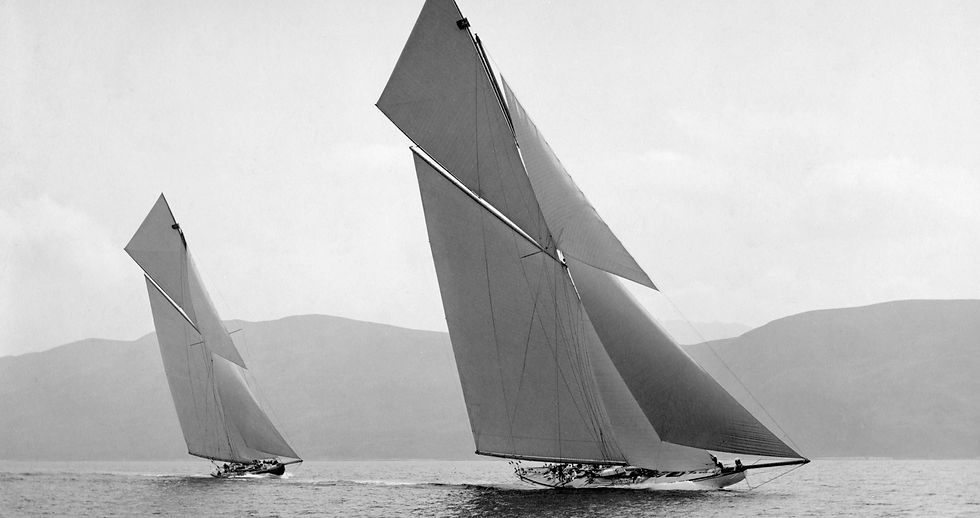In collaboration with two prestigious archive collections, the Scottish Maritime Museum celebrates the three remarkable yacht building dynasties which led Scotland’s golden age of sailing in a new exhibition opening on Saturday (22 February).

Drawing on rare artefacts, original drawings and intricate models from the Mylne Archive and the G.L. Watson Archive, which is held by Scottish Yachting Archives, Crafting Elegance: the Golden Age of Scottish Yacht Design brings to life the extraordinary designs of George Lennox Watson, Alfred Mylne I and II and William Fife I, II and III.
The exhibition, which also features exhibits and historic vessels from the Museum’s own collection, explores how these pioneering designers combined traditional shipbuilding techniques with ground-breaking innovation to push the boundaries of yacht design in the late 19th to mid 20th centuries. Their designs included racing yachts competing in the legendary America’s Cup to luxury vessels commissioned by European royalty and high society.
The exhibition, which goes on show in the Museum’s Linthouse building on Irvine Harbourside, looks at how George Lennox Watson, the world’s first dedicated yacht designer, revolutionised the field by introducing scientific principles to what was once a purely intuitive craft.
It follows the remarkable journey of the Mylnes, whose designs, like those of Watson and the Fifes, graced waters from the Clyde to distant shores across the globe.
Visitors can also immerse themselves in the legacy of the Fife family, learning more about their legendary Fairlie yard and their mastery of design and craftsmanship. On show too are two yachts built by William Fife III – Vagrant and Powerful.
The 1884 Vagrant, which recently underwent a major preservation in the Museum’s Scottish Boat Building School, is thought to be the oldest surviving Clyde-built racing yacht. The small racer Powerful was built in 1900 and is believed to be one of only 50 surviving seaworthy Fife yachts across the world.

Eva Bukowska, Exhibitions and Events Officer at the Scottish Maritime Museum, says:
“We are thrilled to open Crafting Elegance: The Golden Age of Scottish Yacht Design in collaboration with the prestigious Mylne Archive and G.L. Watson Archive.
“The exhibition takes visitors on a compelling journey through a remarkable chapter in Scotland’s maritime history. It has appeal for everyone, whether a sailing enthusiast or simply curious about Scottish innovation and craftsmanship.
“We hope everyone enjoys learning more about these internationally recognised designers whose beautiful, fast and painstakingly crafted vessels were masterpieces of engineering and artistic vision.”
YACHTING DESIGN IN SCOTLAND – OVERVIEW
Sailing emerged as a popular pastime in the mid-19th century. Growing interest in yachting and regattas led to a demand for naval architects and specialist studios and yards sprang up along the coast.
The River Clyde’s geography and rich maritime heritage created the perfect conditions for these three visionary design firms to flourish and soon Scotland became synonymous with excellence in yacht design.
GEORGE LENNOX WATSON (1851 – 1904)
George Watson established his yacht design firm G.L. Watson & Co., in Glasgow at 22 years of age and became the world’s first dedicated yacht designer.
Merging scientific innovation and practical knowledge in yacht design at a time when most designers relied solely on experience and intuition, he helped advance yacht racing technology. Commissions included Britannia, which was built for the Prince of Wales and became one of the most famous racing yachts of all time, and four America's Cup challengers.
He was also renowned for setting new standards in luxury steam yacht design with clients including many European crowned heads as well as the Vanderbilt and Rothschild families. Over 400 vessels of his design were launched during his career.

ALFRED MYLNE I (1872 – 1951)
Securing an early apprenticeship to his hero, G.L. Watson, Alfred Mylne went on to establish his own yacht design office in Glasgow at the age of 24.
He quickly gained a reputation for designing race-winning sailing yachts and helped evolve yacht racing rules, refining his own designs to match. Like Watson and the Fifes, his work influenced a generation of designers and builders worldwide, with collaborations extending to yards in Europe, India, Argentina, Japan and Australia.
Mylne’s success was also shaped by a friendly yet fierce rivalry with fellow Scottish designer William Fife III. The Clyde regattas became a stage for their legendary competition pushing both designers to reach new heights of creativity and innovation and develop some of the finest yachts of the era.
THE ‘WIZARDS OF FAIRLIE’ (EST. 1803)
William Fife I established his boatbuilding yard at Fairlie, Ayrshire, in 1803 and built various style of boat including one of Scotland's early steam-powered vessels. He soon developed a reputation for building craft that were both ‘fast and bonnie’.
During the stewardship of William Fife II, the yard built many of the most successful British racing yachts. Succeeded by William Fife III, the yard’s fame spread worldwide. Designing and building both racing and cruising yachts, the third William Fife also designed two America’s Cup challengers for Sir Thomas Lipton.
At that time, he began the tradition of adding a carved ‘Fife dragon’ to the hulls of yachts built at the yard. A symbol of power and speed, the dragon was possibly chosen as the yard’s ‘logo’ because of the area’s association with the Vikings, who traditionally featured a dragon’s head on their longboats. It is perhaps more likely though due to the success of three racing yachts named ‘Dragon’ which were built for FC Hill.
In the 1920s, Robert Balderston Fife joined his uncle at the yard becoming the fourth and final generation in the firm.
Admission to Crafting Elegance: The Golden Age of Scottish Yacht Design is included in Museum admission.
The Museum is open daily 10am – 5pm. Up to three children go FREE with each Adult/Concession ticket.
